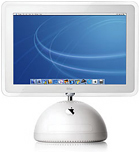
Penn Computing News 2002-2003
Three Leading Edge Laptops

The University's three affiliated laptop vendors have all recently shipped
laptops that represent design leaders for their respective companies.
In late March 2003, Dell's Latitude D600 became commonly available. The
D600 is the first Pentium-M based laptop
from Dell. Along with internal advances in chip and motherboard, the Latitude
D600 is also a complete redesign (including module bay) of the mid-weight
'desktop-equivalent' portion of Dell's five-part laptop line - the first
such redesign in several years. For more detailed information, see ISC's
Latitude
D600 page.
In early April 2003, IBM's ThinkPad T40 became commonly available. The
ThinkPad T40 represents the mid-weight 'desktop-equivelant' portion of
IBM's four-part laptop line. It includes the first Pentium-M
processor on a two-spindle IBM laptop. Mostly because of the change to
the Pentium-M processor, the ThinkPad T40 is almost half a pound lighter
(at 4.9 to 5.3 pounds) than the Pentium 4 Mobile-based ThinkPad T30 it
replaced. For more detailed information, see ISC's ThinkPad
T40 page.
In early April 2003, Apple's PowerBook G4 17-inch became commonly available.
At 6.8 pounds, the new PowerBook boasts features such as a 17.0-inch widescreen
display, standard SuperDrive (ability to burn DVD-Rs), integrated FireWire
800, Bluetooth, and 802.11g, and versatile built-in video support (VGA,
S-Video, composite), all in an aluminum alloy enclosure. For more detailed
information, see ISC's PowerBook
G4 17-inch page.
-- John Mulhern III, Nicholas Allen, Vern Yoneyama, & Kristen Zborowski,
ISC Technology Support Services (April 6, 2003)
Intel's Pentium-M & Centrino

On March 12, 2003 Intel formally released a new line of products (Pentium-M
and Mobile 855 chipset) and debuted a new brand name (Centrino). Centrino
is a new strategic direction for Intel in several ways. For starters,
Centrino is an umbrella brand - one that describes the combination of
three products:
Centrino = Pentium-M + Intel 855 chipset + Intel
802.11b
In mainstream laptops where a combination of good battery life and high
performance is desired, the Pentium-M is intended to replace the Mobile
Pentium 4.
Along with the new Centrino brand comes a new logo, the usual Intel blue
combined with magenta in the shape of an arrow, which Intel says is designed
to convey "a feeling of speed, mobility, and streamlined technology".
For more detailed information, see ISC's Pentium-M/Centrino
page.
-- John Mulhern III, Nicholas Allen, Vern Yoneyama, & Robert Barron,
ISC Technology Support Services (March 13, 2003)
Apple's PowerBook G4 12-inch

On January 7, 2003, Apple introduced a smaller, 12-inch, PowerBook G4.
While only 4.6 pounds (almost a full pound lighter than the current 15-inch
form factor) the new PowerBook boasts features such as integrated Bluetooth
capability, support for 802.11g wireless networking via an optional AirPort
Extreme card, optional SuperDrive (ability to burn DVD-Rs), versatile
built-in video support (VGA, S-Video, composite), all in a strong, compact
aluminum alloy enclosure.
For more detailed information, see ISC's PowerBook
G4 12-inch page.
--Kristen Zborowski & Vern Yoneyama, ISC Technology Support Services
(February 10, 2003)
Dell's OptiPlex SX260

Dell introduced the OptiPlex SX260 systems on October 28, 2002. The SX260
represents the addition of a new, extremely small form factor to Dell's
professional desktop product line - it uses 50% of the space of Dell's
previous smallest desktop configuration (the OptiPlex GX260 small form
factor) and only 15% of the space of an OptiPlex GX260 minitower.
Despite the miniaturization involved, the cost differential between a
SX260 and a similarly configured GX260 is only about $50.
For more detailed information, see ISC's OptiPlex
SX260 page.
--Robert Short & John Mulhern III, ISC Technology Support Services
(February 3, 2003)
PennKey Priority Period: Monday, September 30 - Sunday, October 13
 The
University is implementing enhanced security standards for network access,
and introducing a new authentication system called PennKey. All Penn faculty,
staff, and students are urged to register themselves in the PennKey system
online during the PennKey Priority Period: Monday, September 30 - Sunday,
October 13th. The
University is implementing enhanced security standards for network access,
and introducing a new authentication system called PennKey. All Penn faculty,
staff, and students are urged to register themselves in the PennKey system
online during the PennKey Priority Period: Monday, September 30 - Sunday,
October 13th.
Among the many Penn services switching to the new PennKey system for
login access on Monday, October 14, 2002, are Penn InTouch, Blackboard,
Campus Express, BEN Reports and Deposits, Advisor InTouch, and GRAM. The
new PennPortal for students, set to arrive in late October, will use PennKey
as well.
By registering during the PennKey Priority Period, users can ensure that
their access to these and a growing number of other services remains uninterrupted.
All users who register their PennKeys before midnight on Wednesday, October
9, are also eligible to win a Palm Pilot 515 (courtesy of the Computer
Connection) or one of ten Bookstore gift certificates.
Visit the PennKey website for more information, including Quick Links
to the online PennKey registration site, at http://www.upenn.edu/computing/pennkey
--Robin Beck, Vice President - Information Systems and Computing (September
30, 2002)
PennNet ID Authentication To Be Discontinued on October 14, 2002

The PennNet Authentication
System (also known as PAS) will be discontinued on Monday, October
14, 2002, and will be replaced by a more robust authentication system
called PennKey. The new PennKey system
is based on Kerberos technology, which was developed at MIT and is one
of the most secure authentication methods available today. Beginning October
14, online services that currently use a PennNet ID and password for authenticated
login will instead require a registered PennKey (user ID) and password.
University faculty, staff, and students who have created a PennNet ID
and password before October 14th can use them to conveniently register
online in the new PennKey system before the changeover occurs. Users who
have forgotten their PennNet passwords or who are uncertain about their
PennNet ID status are encouraged to visit a campus
PennNet ID station, where they can reset or create a PennNet password
before October 14th.
PennNet ID stations will be deactivated on October 14, when it will no
longer be possible to create a PennNet ID or to reset a forgotten PennNet
password.
(Note: If you are a UPHS employee who does not currently
have a PennNet ID, or who has forgotten your password, you should not
attempt to create or reset your PennNet ID. Please wait until October
14, and then follow the PennKey registration procedure implemented for
new members of the University community at that time.)
--Mike Lazenka, IT Project Leader, ISC Networking & Telecommunications
(September 18, 2002)
PennConnect CD-ROM Fall 2002
 Information Systems & Computing (ISC) has released the PennConnect
CD-ROM for fall 2002, which contains the recommended networking and anti-virus
software for off-campus students, staff, and faculty, as well as on-campus
ResNet students. The CD-ROM includes the recommended Web browsers and
other Internet applications including clients for terminal emulation,
e-mail, and NetNews.
Information Systems & Computing (ISC) has released the PennConnect
CD-ROM for fall 2002, which contains the recommended networking and anti-virus
software for off-campus students, staff, and faculty, as well as on-campus
ResNet students. The CD-ROM includes the recommended Web browsers and
other Internet applications including clients for terminal emulation,
e-mail, and NetNews.
The CD-ROM features a graphical interface that
guides users through installation and configuration of the software. The
CD-ROM is cross-platform and works on Mac OS 8.6, Mac OS 9.x, Mac OS X.x,
Windows 98, Windows ME, Windows NT, Windows 2000 Professional, and Windows
XP.
Copies are available for many faculty and staff
directly from their local support provider
or at the Computing Resource Center, Suite 202, Sansom Place West, 3650
Chestnut Street. The CRC's hours are M-F, 9-4:30 until 9/13 and then 2-4:30
pm thereafter. The software is also available for download via the network.
The Supported Products page provides additional
information and download links to the software.
--Denise McCole, Operations Manager, ISC Client
Services Group (September 9, 2002)
Apple’s Power Mac G4 (Mirrored Drive Doors)

Apple introduced the Power Mac G4 (Mirrored Drive
Doors) systems on August 13, 2002. The Power Mac G4 (Mirrored Drive Doors)
adds dual processors across the line, DDR memory, greater expandability,
and several other enhancements to the fourth generation of a Power Macintosh
G4 product line Apple originally introduced almost three years ago, in
September, 1999.
Information Systems & Computing (ISC) sees
the Power Macintoshes as evolutionary improvements over the previous generation
"Quicksilver" models.
For more detailed information, see ISC's Power
Mac G4 (Mirrored Drive Doors) page.
--John Mulhern III, Senior IT Project Leader, ISC
Technology Support Services (September 5, 2002)
Mac OS X version 10.2 Jaguar
Mac OS X version 10.2 Jaguar, released on August
24, 2002, is the latest version of Apple’s flagship operating system.
Mac OS X version 10.2 is the second significant update to Mac OS X.

Information Systems & Computing (ISC) will
support Mac OS X version 10.2 for its clients, including off-campus students,
only on new Macintoshes that ship with Mac OS X version
10.2 pre-installed. ISC strongly recommends that all other users adopt
a "wait and see" approach, continuing to use previous versions of the
Mac OS (including Mac OS X versions 10.1.4 and 10.1.5) until the initial
bugs in Mac OS X version 10.2 are identified and fixed.
For more detailed information, see ISC's Mac
OS X version 10.2 page.
--John Mulhern III, Senior IT Project Leader, ISC
Technology Support Services (August 24, 2002)
Apple’s 17-inch iMac/G4

Apple CEO Steve Jobs introduced the iMac 17-inch
system on July 16, 2002 at Macworld Expo New York. The iMac 17-inch adds
a high-resolution wide-screen 17-inch LCD and a few other enhancements
to the iMac/G4 product line Apple introduced in January, 2002.
The iMac 17-inch's primary differentiating feature
is a wide-screen LCD that is 2.4 inches wider than the 15-inch XGA screen
that is on the other iMac/G4s and (at 1440 x 900) has 65% more pixels
- approximately 100 pixels per inch. The display has the same aspect ratio
(8:5) that Apple's $3,150 Cinema
HD Display does.
For more detailed information, see ISC's iMac
17-inch page.
--John Mulhern III, Senior IT Project Leader, ISC
Technology Support Services (July 25, 2002)
Penn Express Modem Pool Discontinued on June 30,
2002

Penn's Express Modem Pool was discontinued on June
30, 2002. The termination plans were first announced two years ago, when
the regular modem pool was discontinued and users were directed to commercial
ISP services for remote access to PennNet and the Internet. Since that
time, the Express Pool had been continued as a transitional service for
the convenience of the Penn community. The Express Pool used aging technology
and did not provide the data transfer speeds that commercial ISPs offer
and that are required to take advantage of many online services.
The termination of the Modem Pool affected about
1,200 individuals, most of whom use the service sporadically, rather than
as their primary means of accessing the Internet from off-campus. Those
who used the Express Modem Pool as their primary ISP can learn about alternatives
from the remote access web page at www.upenn.edu/computing/remote.
The web site provides information on how to get assistance with making
the transition. A useful chart comparing service options and prices is
available at www.upenn.edu/computing/remote/help_chart.html.
--Mike Lazenka, IT Project Leader, ISC Networking
& Telecommunications (July 1, 2002)
|